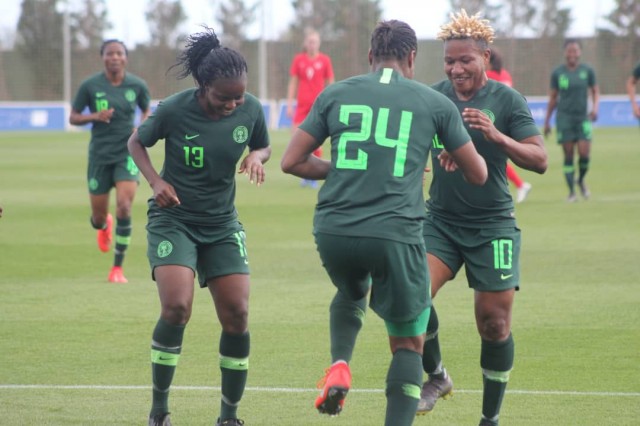Nigeria’s Super Falcons were in the beautiful service city of Murcia in Spain in the past week where they continued their unprecedented preparation towards this summer’s Women’s World Cup in France. During their stay, Thomas Dennerby’s team attempted to showcase what work the Swede has done in the past months especially the new formation he has introduced them to.
World Number 5 Canada were the Falcons’s friendly foes on Monday at the Pinatar Arena and although the record African champions suffered a 1-2 loss, a remarkable progress was visible as compared to the team’s first major game under the Swede, an 8-0 friendly loss to France just over a year ago.
As would be understood by betting folks, the Falcons, courtesy of Desire Oparanozie’s goal even won a half against a Canadian side yet to lose in 2019 and who turned the game around with a couple of substitutions at half time.
The manner of the goals scored by Canada though is one of key areas where the Falcons must do more in their new look 352 formations if they hope to upturn the bookmakers’ odds in June.
READ ALSO: Five key takeaways from Super Falcons’ 8-0 hammering by France
Dennerby earning his pay
Talking of improvements, the most notable aspect of the team’s play – the passing – has greatly improved. I’ve been a keen follower of the women’s national team since 1998 and without any fear to say this; Falcons’ passing and buildup play from the rear on Monday was the best I’ve seen the side in at least nine years – since the 2010 AWCON.
How virtually the same set of players who used to hurriedly get the ball out of around their penalty area regardless of where it lands now have the confidence and mentality to pass around and build slowly is quite fascinating to me and with deserved credit to the expatriate coach.
Passing is an essential ingredient in the game and any team that gets their passing right would have at least solved a fundamental problem which was evident in that game against France as I highlighted in number five of the takeaways from that game.
The team’s switch to a “3-woman” defence since the turn of the year is also noteworthy. It didn’t start quite well in China as they were thumped 4-1 by the Chinese Ladies but they have slowly adapted to the new life which I believe can be a way to surprise the world in France. There is still a lot more to do to get close to perfection of the new formation – which is the main essence of this article – but the initiative on its own has been a productive one for the team.

Falcons’ 352 and present imperfections
I am a big fan of the 352 formation being used by an underdog side. I was one of those that believed Nigeria could have stood a better chance against Croatia at last year’s Men’s World Cup with the 352 they later reverted to against Iceland and Argentina, to great effect too.
Dennerby’s new formation, to a large extent shows that he now knows and understands his players’ abilities better and he also believes they can shock the world in France. I thought they coped well especially in the first half against Canada (with the shape in the picture above) and it showed that they can repeat same against any opposition in the world.
However, I noticed a number of imperfections in the shape that can and must be worked upon:
1. Right wing back Anam Imo playing too up the pitch
For a team that would mostly be the underdogs, you cannot afford your right wing back playing the way Anam Imo did especially in the second half. I felt she played far too up the pitch and this is capable of exposing the back three. Right centre back Osinachi Ohale was arguably Nigeria’s best player on the day and if not for her speed and bravery, Anam’s positioning could’ve caused a great deal of problem for the team.
To put it into proper perspective, Anam is a natural forward and has been playing as a right winger in the Falcons since that 8-0 loss against France but she must be aware that as a wingback now, a 352 should change to 532 when defending. Her overall ball play on the day impressed me though.
2. Ngozi Ebere beside Onome Ebi could be disastrous
Both goals conceded by Nigeria early in the second half came through crosses from Canada’s right flank (Nigeria’s left). That is the area which team captain Ebi plays as left centre back while Ebere who had a stellar AWCON tournament last year played as left wing back.
While Ebere stayed deeper and in position than Anam Imo (as mentioned earlier), her defending was not up to scratch on the day, especially whenever she went into attack. Also, having the oldest member of the squad beside Ebere meant there would be a late catch-up on the balls that bypassed the left wing back. Ebere is absolutely delightful on the ball but her impressive ball work would not benefit the team in the long run if the defensive aspect is as poor as it was on Monday.
Why not Faith Ikidi at left centre back?
I understand that Onome Ebi (a natural right footer)’s good command of both feet could have influenced the decision to play her as left centre back but she will be 36 next month, which means she may not be able to cope (as seen on Monday) with the torrents on the flanks.
Looking further at Ebi’s characteristics, she is the only member of the back three that is gifted and also loves to exhibit her long range of passes, something that easily makes her a good fit for the centre of the back three.
Ikidi who played at the centre against Canada is a natural right back who is also comfortable playing at left back. That to me makes her fitter to play at the Left centre back (LCB) than Onome. Ikidi also loves to take risks such as shielding her ball or dribbling her opponent (as also seen on Monday), something you don’t want the player at your centre to be doing.
With the benefit of hindsight, Ebi could perhaps have won the aerial duel Ikidi lost prior to Canada’s first goal while Ikidi could have done better in closing down the crosses from the right flank.
3. Pressing the opposition
Another function of the modern game which Dennerby seem to have added to the Falcons game is the pressing of the opponents even if it’s still half-hearted. No team can press for the entire ninety minutes in a game but whenever you do, you must do it well.
It was great to see Uchenna Kanu (the first time I’d watch her since the 2014 Under-17 World Cup) but all her productive energy wasted away with her alone trying to press the opponents while Oparanozie also did her own lap. It never brings results, rather weakens the individuals. So, the team must work more on the time and strategy of pressing the opponents as that can also be an integral way of turning over possession in their favour.
4. Set-pieces, crosses, who would deliver Nigeria
From time immemorial, defending set-pieces has always been rocket science for Nigerian teams. From the men’s teams to the women’s teams, this inadequacy has always been portrayed at the global stage. Even Pia Sundhage’s Sweden exploited same when he faced Nigeria at the 2015 Women’s World Cup.
The Canadians troubled the Falcons with each of their corner kicks and crosses on Monday. Each set-play delivery met the Nigerians with an air of uncertainty inside the penalty box, not knowing who to stay with whom or who should deal with the ball. The set-pieces can be a soft target for any of the Falcons’ opposition in France if more resources is not committed into it.
The rest…..
Nigeria played Monday’s friendly without two of their prized attackers – Francisca Ordega and Asisat Oshoala. While that gives the team’s fans some more confidence in the team’s attack, the coach will also grow more grey hairs with the displays of Oparanozie, Kanu and Ini Umotong on how to fit in his indispensable duo.
Another player whose few touches came suggested something interesting was Chinaza Uchendu, a late introduction for Oparanozie. She occupied the role behind the two forwards and showed why she can be a worthy second half outlet whenever Ngozi Okobi is done for the day.
The game against Canada was a great test for what Dennerby has done and is doing and the Nigeria Football Federation (NFF) can only do better to get them at least one, or two of such friendly games before the tournament starts on June 7, 2019.









